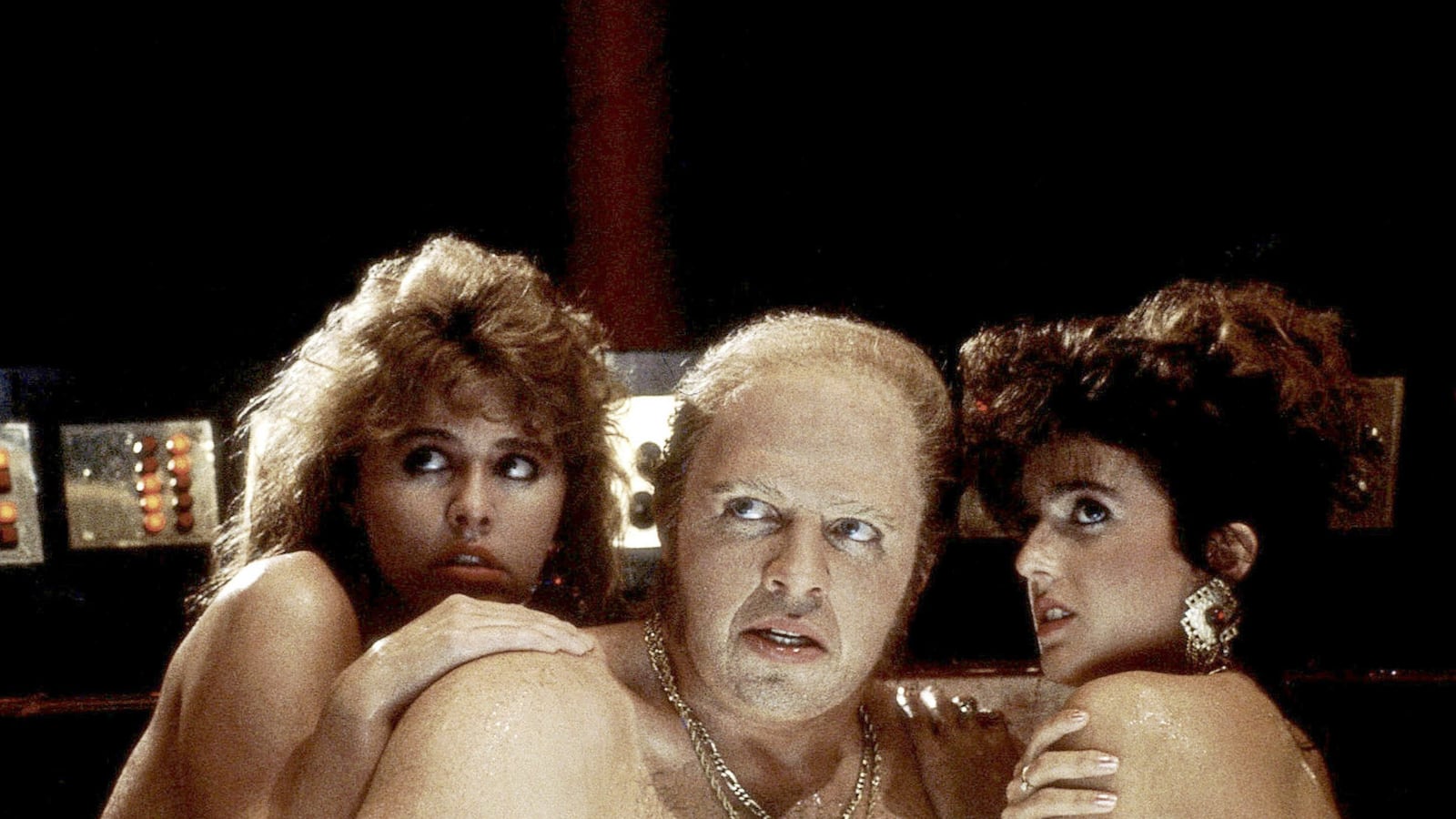There’s a very specific analog between Biff Tannen, the bully and bad guy in almost every timeline in Back to the Future Part II, and a certain political figure who is rather popular in the United States right now. He’s been handed the keys to fortune, he’s unrepentantly used that fortune exclusively for himself, and he’s even become a public advocate for plastic surgery for women in his family.
It is not hard to put two and two together.
So, Bob Gale—writer of Back to the Future Part II and man who helped predict the IMAX theater and the self-checkout line—in these past few months, were you thinking what we’re all thinking?
“We thought about it when we made the movie! Are you kidding?” he says. “You watch Part II again and there’s a scene where Marty confronts Biff in his office and there’s a huge portrait of Biff on the wall behind Biff, and there’s one moment where Biff kind of stands up and he takes exactly the same pose as the portrait? Yeah.”
Of course, in the movie, Biff uses the profits from his 27-story casino (the Trump Plaza Hotel, completed in 1984, is 37 floors, by the way) to help shake up the Republican Party, before eventually assuming political power himself, helping transform Hill Valley, California, into a lawless, dystopian wasteland, where hooliganism reigns, dissent is quashed, and wherein Biff encourages every citizen to call him “America’s greatest living folk hero.”
“Yeah,” says Gale. “That’s what we were thinking about.”
Of course, in Back to the Future Part II, Marty McFly and Doc Brown fix it all just in the nick of time. They save themselves and America from Donald Tr… Biff Tannen.
Now, today, Marty and Doc are here to deliver the rest.
Today is the Future.Here’s the bad news: Today, October 21, 2015, is the day Marty and Doc arrive in Downtown Hill Valley, California, to save Marty from going to jail, then go on your standard 2015 stolen hoverboard chase through the main street of an American town. So if you’re downtown, you might want to hoverchain your hoverboard to a hoverfire hydrant.
But here’s the good news: Bob Gale is very optimistic about our future. He’s thinking it’s closer to the borderline utopian one in his brain in the 1980s than the dystopian one he’d also dreamt up.
And that’s tremendous news for us all, because Bob Gale was very, very right the first time.
“We wanted to portray an optimistic, enjoyable, fun future, where the characters are still a mess,” he tells The Daily Beast.
Gale and director Robert Zemeckis did just that. In 2015, Marty wanders around the town square and is attacked by a 3D hologram of what would eventually be known as an IMAX 3D version of Jaws 19.
“We don’t have Jaws 19, but we have Sharknado 3,” he says.
At Cafe ’80s, Marty orders a Pepsi from Michael Jackson and Ronald Reagan imitators, the celebrity voices of what we’d now consider self-checkout lines.
And at the dinner table, Marty’s future kid even checks his phone. Sure, it’s on the giant sunglasses affixed to his face, but he’s still off in his own world.
“Nobody gets it right. You might get a few things right, but you’re gonna get a lot of things wrong,” says Gale. “We missed the smartphone entirely. How did we miss that? We just missed it. Everybody else missed it, too. It took Steve Jobs to come along and say, ‘Everybody, you’re gonna need this.’ In the future, trust me, there will be something else.”
But here’s the beautiful thing about Bob Gale’s 2045: It’s just as optimistic as his imagined 2015. He thinks there’s going to be something he calls GoogleMD, for example.
“It’ll be able to do a whole bio-examination of you, compare it to the data that Google has on 400 million other people, and be able to say ‘You need to cut back on the ice cream,’” he says.
But the truly gorgeous part of his future is that it will take the ugly, broken, pubescent cultural quagmires of now, and it will make them transcendent, comfortable, or even empowering.
“Privacy is going away. We’re not gonna have it anymore,” he says.
How do you deal with that? “You deal with it by not having any shame about the stupid stuff that you do. Because if that picture somebody took on Facebook of you being drunk, running down the street naked—if that gets out there— what are you gonna say?” he asks.
“You’re gonna say, ‘Welp, I was drunk. I took off my clothes. Haven’t you ever been there?’ So am I gonna be worried about that? No.”
If that sounds like a better future, a more hopeful future than now, it’s because it is.
“That’s what Bob Zemeckis and I believe: These movies are about personal responsibility. You need to be responsible for your own future, and if you do the right thing now, it’ll have positive results in the future,” says Gale.
Gale brings up the time Marty McFly travels to a timeline where his mother winds up becoming an alcoholic.
“If you do the wrong thing—‘You shouldn’t drink!’ ‘Why not?’ ‘You might regret it later in life!’—and it’s because he knows she’s a drunk? People think about that,” says Gale.
There’s a certain religion in that, isn’t there?
“‘Your future is exactly what you make of it,’ as Doc Brown would say. I’ve had people come up to me and say, ‘That bit of advice was really important for me to hear,’” he says.
“Look, people love Star Wars, but I don’t think ‘Use the Force’ is gonna help you live your everyday life.”
Now, Gale gets to do one last victory lap. He and Michael J. Fox and Christopher Lloyd and Lea Thompson and co-writer Robert Zemeckis (and maybe, according to rumors, a pair of Nike Air Marty McFlys with power laces) will be at the Lincoln Center AMC Theater tonight, October 21, 2015, The Future, talking about everything they all got to act out that came from Gale’s big, futuristic brain.
And it’s about time. Since the early days of Photoshop, and even before it, Back to the Future fans have been so impatient for this day to come, they would doctor the screenshot of Doc Brown’s flux capacitor so it read every October 21 for, oh, the last 18 years.
“The hoaxes! If you go back to 1997 when the Florida Marlins won the World Series, they were saying, ‘This is the day from Back to the Future!’” says Gale. “I guess they just wanted a hoverboard.”
But now it’s really here, and Gale is still humbled by the entire idea of it.
“What is the movie of the last 10 years that we’ll be celebrating a 30th anniversary of that people will still be interested in?” he asks. “On the other hand, even in 1995, did people really believe in 2015 people would be talking about Back to the Future? Probably not. But it’s been very, very good to me.”
And what’s the driving force behind why this movie has endured? Why did it work in a theater in 1989, and on a VHS tape in the ’90s, and on a DVD in the ’00s, and for a kid seeing it on an iPad, beamed wirelessly, like magic, into a moving car, for the first time, today, The Future?Why does it still hold up?
Because the hate in it still loses. (We’re looking at you, Biff.) And the hope for a better future—hoverboard or not—is still possible.
“Growing up in the ’50s and ’60s, technology was our God. It gave us hope. It permeated our generation. And I think every kid today is still sitting, thinking, daydreaming about the future,” he says. “I hope so. I hope they are.”






